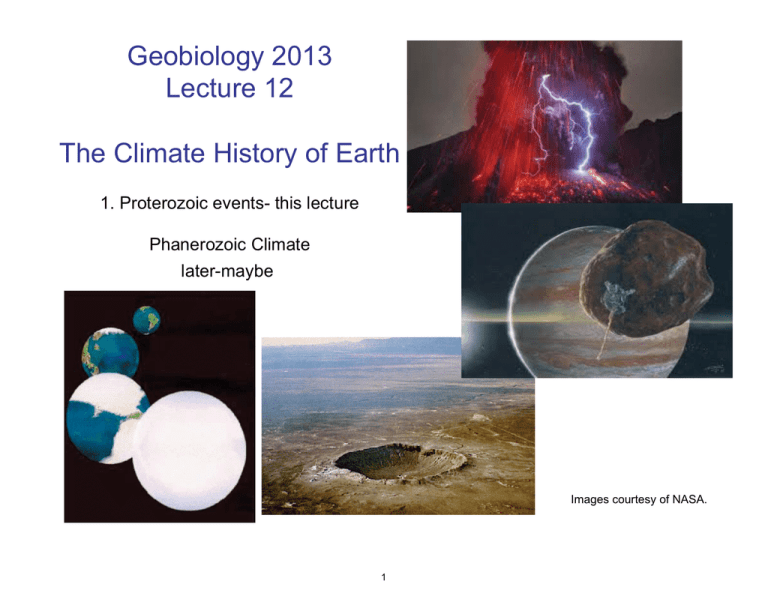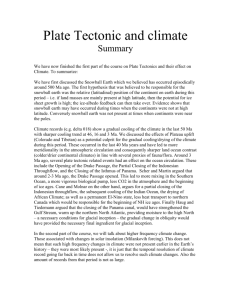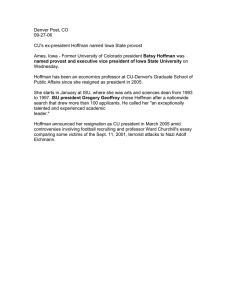
Geobiology 2013 Lecture 12 The Climate History of Earth
1. Proterozoic events- this lecture
Phanerozoic Climate later-maybe
Images courtesy of NASA.
1
Need to know
Timing of 5 periods of 'extreme' climate in Earth's history
Elements of Snowball Earth Theory
Evidence for widespread, low latitude glaciations at end of
Precambrian
Scenarios to enter extreme climate states
Scenarios to escape
Possible role in evolution of multicellular complex life
2
Assigned Readings
Hoffman & Schrag, Snowball Earth,
Scientific American January 2000
This image has been removed
due to copyright restrictions. Hoffman & Schrag, The snowball Earth
hypothesis: testing the limits
of global change, Terra Nova 2002
Stanley, pp. 84-101 & 288-289
See also: http://www.snowballearth.org 3
Extras:
Kump LR, Kasting JF and Crane RG (1999) The Earth
System, Chap. 7.
Royer DL, Berner RA, Montanez IP, Tabor NJ and
Beerling DJ, CO2 as a primary driver of Phanerozoic
climate GSA Today March 2004, pp. 4-10
Lubick (2002) Nature, Vol. 417: 12-13.
Hoffman, P.F., 2008. Snowball Earth: status and new developments. GEO (IGC Special Climate Issue) 11, 44-46.
Images courtesy of NASA.
Animals and the invention of the Phanerozoic Earth System�
Nicholas J. Butterfield
Trends in Ecology and Evolution, February 2011, Vol. 26, No. 2 4
Recap on O2-Paradigm • The C-cycle has evolved radically through time
• Prior to 2.2 Ga anaerobic prokaryotes dominated;
wide spread of δorg (δo) values; oxygenic
photosynthesis extant but oxygen remained low as
sinks >> sources
• Mantle may have been an important sink for
electrons ie oxidising power (Cloud/Holland)
• Extreme δcarb (δa) values around 2.2 Ga probably
signify the 'GOE' and rise to prominence of
aerobes; Decreased spread of δorg (δa) values
may reflect dominance of aerobic autotrophs and
reductive pentose (Benson-Calvin; C3) cycle
5
Recap on O2-Paradigm • Although ample evidence for aerobes, the
abundance of O2 in atm and ocean remained low
(sulfidic ocean) until another major oxidation
event caused a second 'reorganization' In the
Neoproterozoic. This was also signified by
extreme δa fluctuations.
• The Neoproterozoic 'reorganization' culminated
in pO2 rising to near PAL allowing animals to
flourish and stabilizing of the new regime.
• Environmental evolution reflected changes in the
balance between thermal, crustal, atmospheric &
biological processes
6
This image and its caption have been removed due to copyright restrictions. Please see: Figure 1. in A. D. Anbar and A. H. Knoll, Proterozoic Ocean Chemistry and Evolution: A Bioinorganic Bridge? Science 2002, 297, 1132. 7
GSA Bulletin;
September 2005; v.
117; no. 9-10; p.
1181-1207;
Toward a
Neoproterozoic
composite carbonisotope record
Galen P. Halverson,
Paul F. Hoffman,
Daniel P. Schrag,
Adam C. Maloof and
A. Hugh N. Rice
Image courtesy of the Geological Society of America. Used with permission.
8
GSA Today�
Volume 14, Number 3, March 2004
Image courtesy of the Geological Society of America. Used with permission.
9
Outline •Overview
of Earth's climate history
•Climate
feedbacks: what keeps climate away from extremes?
Planetary Energy Balance
Greenhouse Effect
Geochemical Carbon Cycle, CO2
Temperature, Precipitation-Weathering Feedback
•Case
studies:Neoproterozoic glaciations (750-580 Ma)
•http://www.snowballearth.org/
Permo-carboniferous Glaciations (300-275 Ma) Mesozoic Warmth (245-65 Ma) Cenozoic Cooling (100-0 Ma) Pleistocene Glaciations (0.5-0 Ma) 10
Earth'
's Climate History: Mostly sunny with a 10% chance of snow
This image has been removed due to copyright restrictions.
Images courtesy of NASA. 11
Climate Controls - Long & Short Timescales
•Solar
output (luminosity): 109 yr
•Continental
drift (tectonics): 108 yr
•Orogeny
(tectonics): 107 yr
•Orbital
geometry (Earth -Sun distance): 104-105 yr
•Ocean
circulation (geography, climate): 101 -103 yr
•Composition
of the atmosphere (biology, tectonics,
volcanoes): 100-105 yr
12
Faint
Faint Young Sun Paradox
Young
Sun
Paradox
4 1H-->4He
Incr. density=
incr. luminosity
Liquid H2O existed
>4 Ga (sed. rocks,
life, zircon δ18O)
13
Contemporary Solar Variability Image removed due to copyright restrictions.
Please see Fig. 9 in Fröhlich, C. “Solar Irradiance
Variability Since 1978.” Space Science Reviews
125 (August 2006): 53-65.
•Contemporary Solar Variability ~0.1%
•Associated with 11-year sunspot cycle
14
Energy Balance�
S= solar flux�
T = effective radiating temperature�
A= albedo or reflectivity as a fraction of incident radiation�
RE = earth radius Stefan_Boltzmann law
Energy Flux = const* T4
Const σ = 5.67 * 10-8 w/m2/K4
The Stefan–Boltzmann law states that the total energy radiated per unit surface
area of a black body in unit time (known variously as the black-body irradiance,
energy flux density or radiant flux, j*, is directly proportional to the fourth power
of the black body's absolute temperature):
15
Adapted from Kump et al. (1999)
Therefore:
Lower S must have been compensated by larger greenhouse effect
16
Greenhouse
Gases:
Those that absorb IR
radiation efficiently
N2O, CO2, CH4, H2O
17
Image removed due to copyright restrictions.
Please see Fig. 1 in Hofmann, D. J., et al. “Tracking
Climate Forcing: The Annual Greenhouse Gas Index.”
Eos 87 (November 14, 2006): 509-511.
18
Image removed due to copyright restrictions.
Please see Fig. 2 in Hofmann, D. J., et al. “Tracking
Climate Forcing: The Annual Greenhouse Gas Index.”
Eos 87 (November 14, 2006): 509-511.
19
How much CO2 Required for TS > 0°C? Image removed due to copyright restrictions.
Please see Fig. 2 in Kasting, James F. “Earth’s
Early Atmosphere.” Science 259 (February 12,
1993): 920-926.
http://www.geosc.psu.edu/~kasting/PersonalPage/
Pdf/Science_93.pdf
*Venus: Same qty. of C as Earth;
All in atmos. -> TS < 450°C
20
Earth'
's Climate History: Mostly sunny with a 10% chance of snow
This image has been removed due to copyright restrictions.
Images courtesy of NASA.
What caused these climate perturbations?
21
Steady State & Residence Time Steady State: Inflows = Outflows Any imbalance in I or O leads to changes in reservoir size
Inflow:
60 Gton C/yr
Respiration
Atmospheric CO2�
�
760 Gton C�
Outflow: 60 Gton C/yr
Photosynthesis
1 Gton = 109 * 1000 kg = 1015 g
The Residence time of a molecule is the average amount of
time it is expected to remain in a given reservoir.
Example: tR of atmospheric CO2 = 760/60 = 13 yr 22
The Biogeochemical Carbon Cycle
23
Chemical Weathering = chemical attack
of rocks by dilute acid
C O2 + H2O <---> H2CO3
----------------------------------------------
The
Biogeochemical
Carbon Cycle
1. Carbonate Weathering:
C a C O3 + H2CO3 --> Ca2 + + 2 HCO3-
2. Silicate Weathering:
C a S i O3 + 2 H2CO3 --> Ca2 + + 2HCO3- + SiO2 + H2O
------------------------------------• 2x CO2 consumption for silicates
• Carbonates weather faster than silicates
24
Image removed due to copyright restrictions.
25
Carbonate
rocks weather faster than silicate rocks! Products of
weathering
precipitaed as CaCO3 & SiO2 in ocean
Image removed due to copyright restrictions. Please see Kump, L. R., et al. The Earth System. Upper
Saddle River, NJ: Pearson Prentice Hall, 1999.
26
Net Reaction of Rock Weathering
+
Carbonate and Silica Precipitation in Ocean
CaSiO3 + CO2 --> CaCO3 + SiO2
• CO2 consumed (~ 0.03 Gt C/yr)
• Would deplete atmospheric CO2 in 20 kyr
• Plate tectonics returns CO2 via Volcanism
and Metamorphism
------------------------------------Carbonate Metamorphism
C a C O3 + SiO2 --> CaSiO3 + CO2
• CO2 produced from subducted marine
sediments
27
Net reaction of geochemical carbon cycle
(Urey Reaction) Carbonate-Silicate Geochemical Cycle
•CO2 released from volcanism
dissolves in H2O, forming
carbonic acid H2CO3
Image removed due to
copyright restrictions.
Please see Fig. 10-11 in
Stanley (course text).
•H2CO3 dissolves rocks
•Weathering products
transported to ocean by rivers
•CaCO3 precipitation in shallow & deep water
•Cycle closed when CaCO3
metamorphosed in subduction
zone or during orogeny.
28
• Geologic record indicates climate has
rarely reached or maintained extreme
Greenhouse or Icehouse conditions....
• Negative feedbacks between climate and
Geochemical Carbon Cycle must exist
• Thus far, only identified for CarbonateSilicate Geochemical Cycle:
Temp., rainfall enhance weathering rates
How are
CO2 levels
kept in
balance?
(Walker et al, 1981)
(I.e., no obvious climate dependence of tectonics
or organic carbon geochemical cycle.)
Feedbacks
Adapted from Kump
et al. (1999)
29
The Proterozoic Glaciations (''Snowball Earth') http://www.snowballearth.org
Reading:
•Hoffman
& Schrag (2002) Terra Nova, Vol. 14(3):129-155.
•Lubick
(2002) Nature, Vol. 417: 12-13.
30
Images courtesy of NASA.
Figure 1. (A) Present-day locations of the Neoproterozoic successions Image courtesy of the Geological Society of America. Used with permission.
GSA Bulletin; September 2005; v. 117; no. 9-10; p. 1181-1207; Toward a Neoproterozoic composite carbon-isotope record Galen P. Halverson, Paul F. Hoffman, Daniel P. Schrag, Adam C. Maloof and A. Hugh N. Rice 31
δ13C limestones
Carbon Isotopic Excursions 800-500Ma
δ13C marine
organic matter
What caused these
massive perturbations to the carbon cycle during the late Proterozoic?
13C fractionation
εTOC
750 Ma 720 Ma
580 Ma
f organic-C buried
Sturtian
glacial(s)
Marinoan/Varanger
glacial(s) Courtesy Elsevier, Inc., http://www.sciencedirect.com. Used with permission.
32
Hayes et al, Chem Geol. 161, 37, 1999 Neoproterozoic Glaciations: Evidence
3-4 global glaciations followed by extreme greenhouses 750-580 Ma
•Harland (1964); Kirschvink (1992)
•Hoffman et al. (1998) Science, v. 281: 1342-6; Hoffman & Schrag (2000) Sci. Am., Jan: 68-75.
Image removed due to
copyright restrictions.
Please see Fig. 3 in Hoffman,
Paul F., and Schrag, Daniel P.
“Snowball Earth.” Scientific
American 282 (January 2000): 68.
Snowball-related Events:
•Breakup of equatorial supercontinent 770
Ma
•Enhanced weathering from increased
rainfall (more land close to sea)
•Drawdown atmospheric CO2 � Global
cooling
•Runaway albedo effect when sea ice <
30° latitude
•Global glaciation for ~10 Myr (avg T ~ ­
50°C)
•Sea ice ~1000 m thick, geothermal heat
flux (0.07 W/m2) keeps ocean liquid
33
Tillites
Packed pebbles, sand &
mud. Remnants of
moraines
Copyright Marli Miller, University of Oregon.
Image from Earth Science World Image Bank,
http://www.earthscienceworld.org/images
Used with permission.
Geologic
Evidence
for Glaciers
Glacial Striations
Scratches from rocks dragged by moving ice Courtesy Walter Siegmund. Image from Wikimedia
Commons, http://commons.wikimedia.org
Used with permission.
Dropstones:
Rocks transported by icebergs which
melt, releasing load into finely
laminated sediment (IRD)
Copyright Bruce Molnia, Terra Photographics.
Image from Earth Science World Image Bank,
http://www.earthscienceworld.org/images
Used with permission.
34
Kump et al. (1999)
Glacial sediments – poorly sorted, angular clasts
including dropstones – Namibia c. 750 Ma
Courtesy Daniel Schrag. Used with permission.
35
Neoproterozoic Glacial Deposits Image removed due to copyright restriction.
Please see Fig. 2 in Hoffman, Paul F., and
Schrag, Daniel P. “The Snowball Earth
Hypothesis: Testing the Limits of Global
Change.” Terra Nova 14 (2002): 129-155.
From Norway, Mauritania, NW Canada, Namibia, Australia Oman •Glacial striations •Dropstones
•Diamictites
•Anomalous Iron
Formations
36
Equatorial Continents?
Image removed due to copyright restrictions.
Please see Fig. 1 in Hoffman, Paul F., and Schrag,
Daniel P. “Snowball Earth.” Scientific American 282
(January 2000): 68.
•Harland & Rudwick (1964) identified glacial sediments at what looked like equatorial
latitudes by paleomagnetism.
•George Williams (1975) identified low a latitude glacial sequence in S. Australia &
attributed to episode of extreme obliquity (tilt).
37
Determining Paleolatitude from Remnant Magnetism •Paleomagnetism:
latitude
of formation of rock
•Natural
Remnant
Magnetism (NRM):
inclination varies with
"magnetic" latitude
-vertical @ magn poles
-horz. @ magn equator
(many Neoprot glac
deposits)
This image has been removed due to copyright restrictions.
•Magn
polar drift avgs out
on T~10 ky
Image from P. Hoffman 38
Paleolatitude from Paleomagnetism Image removed due to copyright restriction.
Please see Fig. 1 in Hoffman, Paul F., and
Schrag, Daniel P. “The Snowball Earth
Hypothesis: Testing the Limits of Global
Change.” Terra Nova 14 (2002): 129-155.
39
What can explain glaciers on
all continents when they
appear to have been close to
the equator?
40
High Obliquity Hypothesis
George Williams (1975) •Earth'
's tilt (obliquity)
controls seasonality
high tilt angles (> 54°)
•At
the poles receive more
mean annual solar radiation
than the tropics (sun
constantly overhead in
summer)!
•Glaciers
may be able to
form at low latitudes
Problems:
•Even
the tropics get quite
warm at the equinoxes
•Moon
stabilizes obliquity
need v. large impact
•Would
to destabilize; moon orbit
doesn't support this
This image has been removed due to copyright restrictions.
Image from P. Hoffman
41
Snowball Earth Hypothesis
~3-4 global glaciations followed by extreme greenhouses 750-580 Ma
•Harland
(1964); Williams 1976-86; Kirschvink (1992)
•Hoffman
et al. (1998) Science, v. 281: 1342-6; Hoffman & Schrag (2000) Sci. Am., Jan:
68-75.
Images courtesy of NASA.
Snowball Events:
•Breakup
of equatorial supercontinent
770 Ma
•Enhanced
weathering from increased
rainfall (more land close to sea)
•Drawdown
atmCO2 � Global cooling
•Runaway
albedo effect when sea ice <
30° latitude
•Global
glaciation for ~10 Myr (avg T ~
-50°C)
•Sea
ice ~1000 m thick, geothermal
heat flux (0.07 W/m2) keeps ocean
liquid
42
‘Prologue’ to Snowball •Breakup of
equatorial
supercontinent
•Enhanced
weathering from
increased rainfall
(more land close to
sea) + carbon
burial??
•Drawdown
atmospheric CO2
� Global cooling Image removed due to
copyright restrictions.
Please see Fig. 2 in Hoffman,
Paul F., and Schrag, Daniel P.
“Snowball Earth.” Scientific
American 282 (January 2000): 68.
•Is this enough???
43
Deep Freeze •Global cooling causes
sea ice margin to move
equatorward
Image removed due to
copyright restrictions.
Please see Fig. 2 in Hoffman,
Paul F., and Schrag, Daniel P.
“Snowball Earth.” Scientific
American 282 (January 2000): 68.
•Runaway albedo effect
when sea ice <30°
latitude
•Entire ocean possibly
covered with ice
44
Budyko-Sellers Runaway Albedo Feedback 1.
2.
3.
This image has been removed due to copyright restrictions.
4.
5.
Eq continents, incr
weathering, lowers
CO2, slow cooling,
equatorward
movement of ice.
Runaway albedo
Slow buildup of CO2
from volcanoes
Rapid decay of ice in
102 yr. High Ts from
enhanced H20-T
feedback.
Slow CO2 drawdown
from weathering
Image from P. Hoffman 45
�
Profiles of the 1998 Blue Planet Prize Recipients
�
Dr. Mikhail I. Budyko (Д-р. Μ.И. Будыко) �
(Born in January 1920 in Gomel in the former Soviet Union (now Belarus)�
Head of the Division for Climate Change Research, State Hydrological Institute, St. Petersburg�
�
As shown by the unusual weather patterns caused by the El Nino effect, a wide spectrum of
climate changes on Earth is having a profound effect on human lives and the environment. Since
the 1970s, great advances have been made in climatology, the scientific study of the close
relationship between climate and the environment. Playing a pivotal role in the development of
climatology has been Dr. Mikhail I. Budyko, one of this year's winners of the Blue Planet Prize.�
In the 1950s, Dr. Budyko conducted quantitative studies of the global climate by calculating the
heat balance of the Earth's surface. This balance involves energy from the sun, which is the most
important determining factor for the Earth's climate. First, Dr. Budyko calculated the energy
balance of certain regions of the Earth, and then he verified his calculations by making
comparisons with observational data. Next, using weather data collected from all over the world,
Dr. Budyko carried out heat balance calculations for all regions of the world and confirmed that
they checked out with observational data. He announced his findings in 1956 with the publication
of his book Heat Balance of the Earth's Surface.
46
Snowball Peak Image removed due to
copyright restrictions.
•Global glaciation for ~10
Myr (avg T ~ -50°C)
Please see Fig. 3 in Hoffman,
Paul F., and Schrag, Daniel P.
“Snowball Earth.” Scientific
American 282 (January 2000): 68.
•Sea ice ~1000 m thick,
geothermal heat flux (0.07
W/m2) keeps ocean liquid
47
Breaking out of the Snowball
•Volcanic outgassing of CO2
over ~106 yr may have
increased greenhouse effect
sufficiently to melt back the
ice.
Image removed due to
copyright restrictions.
Please see Fig. 2 in Lubick,
Naomi. “Palaeoclimatology:
Snowball Fights.” Nature 417
(May 2, 2002): 12-13.
48
Bring on the Heat: Hothouse follows Snowball?
Hothouse Events
•Slow CO2 buildup to ~350
PAL from volcanoes
•Tropical ice melts: albedo
feedback decreases, water vapor feedback increases
•Global T reaches ~ +50°C in
102 yr
•High T & rainfall enhance
weathering
•Weathering products + CO2 =
carbonate precipitation in
warm water
Image removed due to
copyright restrictions.
Please see Fig. 3 in Hoffman,
Paul F., and Schrag, Daniel P.
“Snowball Earth.” Scientific
American 282 (January 2000): 68.
49
Evidence for Snowball Earth Hypothesis
•Stratigraphy:
globally-dispersed glacial deposits.
•Carbon
isotopes: negative δ13C excursions through glacial
sections (δ13C reaches ~ -5 to -7‰). Little or no biological
productivity (no light).
•Anomalous
banded iron formations w/IRD: only BIFs after 1.7
Ga. Anoxic seawater covered by ice.
•Cambrian
explosion: Rapid diversification of multicellular life
575-525 Ma expected to result from long periods of isolation and extreme environments (genetic "bottleneck and flush"). 50
Carbon Isotopic Evidence for Snowball δ13C values of -5‰ (mantle value) consistent with "dead" ice-covered
ocean
This image has been removed due to copyright restrictions.
Image from P. Hoffman 51
Carbon Isotope Fractionation This image has been removed due to copyright restrictions.
•As
fraction of organic
carbon buried
approaches zero, δ13C
of CaCO3 approaches
mantle (input) value
Image from P. Hoffman 52
Carbon Isotopic Excursions �
800-500Ma δ13C limestones
More complete sediment record +
δ13C marine
organic matter
Improved chronology =
More detailed picture showing abrupt and extreme C-isotopic shifts 13C fractionation
εTOC
A global composite of 13C data shows 4 excursions f organic-C buried
Plus one at the pC-C
boundary
Hayes et al, Chem Geol. 161, 37, 1999
Courtesy Elsevier, Inc., http://www.sciencedirect.com. Used with permission.
53
This image has been removed due to copyright restrictions. Please see Figure 2. Details -> Calibrating the Cryogenian Francis A. Macdonald, Mark D. Schmitz, James L. Crowley, Charles F. Roots, David S. Jones, Adam C. Maloof, Justin V. Strauss,Phoebe A. Cohen, David T.
Johnston, Daniel P. Schrag SCIENCE VOL 327 5 MARCH 2010
Fig. 2. Neoproterozoic composite carbonate d13C
chemostratigraphy with U-Pb ID-TIMS ages that
are directly linked to isotopic profiles (11). Bars
indicate the time spans of fossil assemblages
representing eukaryotic crown groups. Asterisks
indicate fossil groups of uncertain
taxonomic affinity. Bars faded upward reflect
uncertainty in the minimum age constraint; bars
faded downward reflect uncertainty in the
maximum age constraint. Dashes represent the
time span where a fossil record has not been
identified but for which the eukaryotic group's
presence is inferred from its occurrence in
Ediacaran or Phanerozoic strata. Dashes with
question marks indicate that earlier records have
been proposed but the relationships between
these fossils and the crown groups are uncertain.
54
Anomalous Banded Iron Formations •After
a ~1 Gyr absence,
BIFs return to the geologic
record
This image has been removed due to copyright restrictions.
•Implies
an anoxic ocean
•Consistent
with ice-covered
ocean
Image from P. hoffman 55
BIF + Dropstone = Ice-covered, anoxic ocean? This image has been removed due to copyright restrictions.
McKenzie Mtns., Western Canada�
56
Image from P. Hoffman Animal Radiation: Response to genetic bottlenecks & flushes?
This image has been removed due to copyright restrictions.
Image from P. Hoffman 57
This image has been removed due to copyright restrictions.
One Complete Snowball-
Hothouse Episode Image from P. Hoffman 58
The Geochemical Carbon Cycle IThis image has been removed due to copyright restrictions.
Image from P. Hoffman 59
Geologic Evidence for Hothouse Aftermath:�
"Cap Carbonates"�
�
Thick sequences of inorganically precipitated CaCO3 overly all Neoproterozoic glacial deposits
60
Neoproterozoic Cap Carbonates-1 Image removed due to copyright restriction.
Please see Fig. 3 in Hoffman, Paul F., and
Schrag, Daniel P. “The Snowball Earth
Hypothesis: Testing the Limits of Global
Change.” Terra Nova 14 (2002): 129-155.
61
•Thick sequences of
inorganically precipitated
carbonate minerals overly
Late Proterozoic glacial
deposits.
•Consistent with massive
flux of weathering
products to ocean in
snowball aftermath.
Cap Carbonates 3 Image removed due to copyright restriction.
Please see Fig. 5c in Hoffman, Paul F., and
Schrag, Daniel P. “The Snowball Earth
Hypothesis: Testing the Limits of Global
Change.” Terra Nova 14 (2002): 129-155.
•Namibia
62
Image removed due to copyright restrictions.
Please see Prof. Hoffman's site on the Snowball Earth hypothesis,
http://www.snowballearth.org/
Glacial Deposit Overlain by Cap Carbonate in
Namibia (~700 Ma)
Hoffman &
Schrag (2000)
63
Image removed due to copyright restriction.
Please see Fig. 9 in Hoffman, Paul F., and
Schrag, Daniel P. “The Snowball Earth
Hypothesis: Testing the Limits of Global
Change.” Terra Nova 14 (2002): 129-155.
64
Geologic &
Isotopic Change
Associated with
Snowball Event
(Namibia) How Long Did it Last?
•Big open question! Recent work by Sam Bowring (MIT) suggests Gaskiers glacial episode lasted < 1 Myr
Image removed due to copyright restrictions.
Please see Prof. Hoffman's site on the Snowball Earth hypothesis,
http://www.snowballearth.org/
•Canadian glacial
episode, with good age
controls, probably
lasted < 1 Myr
•Cap carbonates likely
deposited within 103­
104 yr
Image from P. Hoffman 65
How Long Did it Last? Gaskiers Fm.
Newfoundland
Images removed due to copyright restrictions.
Images from S Bowring 66
How Long Did it Last?
Ediacaran-burying ash
(Drook Formation)
Images removed due to copyright restrictions.
Image from S Bowring 67
What kept this from happening after ~580 Ma?
•Higher solar luminosity (~5% increase)
•Less landmass near equator = lower weathering rates (?)
� John Edmond: weathering rates limited by
abundance of fresh rock, not temperature.
•Increased bioturbation (eukaryote diversity following reoxygenation of ocean): Less C accumulation in sediments
offsets lower weathering rates.
•lower iron and phosphorous concentrations in betteroxygenated Phanerozoic ocean [Fe(II) is soluble; Fe(III) is
less so]: Decreased 1° production = Decreased CO2
drawdown.
� What we would like to know:
CO2 concentrations through snowball/hothouse cycle.
68
Potential Problems with the ‘Snowball Earth hypothesis’ Image removed due to
copyright restrictions.
•Ocean/atmosphere climate
models cannot seem to keep
entire ocean covered with ice.
•No evidence for lower sea
level.
•Weathering reactions are
slow….. Maybe too slow to be
the source of cap carbonates.
Please see Lubick, Naomi.
“Palaeoclimatology: Snowball
Fights.” Nature 417 (May 2,
2002): 12-13.
69
Alternate Cause for Cap Carbonate Deposition & 13C Depletions:
Gas Hydrate Destabilization
Kennedy et al. (2001) Geology Vol. 29(5): 443-446.
•CaCO3 precipitation does not require increased
weathering flux of minerals.
•Can be caused by increased seawater alkalinity
resulting from CH4 consumption by sulphate­
reducing bacteria.
70
Structures in Cap Carbonates May Result from Gas Release •Gas Hydrate = [H2O +
hydrocarbon (CH4)] ice
•CH4 from biogenic +
thermogenic
decomposition of
deeply buried Corg
•Biogenic CH4 has very
low o13C (-60 to-90‰)
•Sequestered as hydrate
in permafrost (> 150 m)
& along continental
margins (> 300 m)
•Destabilized by
increased temperature
•CH4 released from
flooded permafrost
during deglaciation
Image removed due to copyright restrictions.
Please see Fig. 1 in Kennedy, Martin J., et
al. “Are Proterozoic Cap Carbonates and
Isotopic Excursion a Record of Gas Hydrate
Destabilization Following Earth’s Coldest
Intervals?” Geology 29 (May 2001): 443-446.
71
A Biogeochemical Model of the Proterozoic Ocean
Image removed due to copyright restrictions.
Please see Fig. 3a in Logan, Graham A., et
al. “Terminal Proterozoic Reorganization of
Biogeochemical Cycles.” Nature 376 (July 6,
1995): 53-56.
72
After Ventilation
Image removed due to copyright restrictions.
Please see Fig. 3b in Logan, Graham A., et
al. “Terminal Proterozoic Reorganization of
Biogeochemical Cycles.” Nature 376 (July 6,
1995): 53-56.
73
A Carbon Cycle with Two Timescales
oi
weathering, volcanism
o1 '1
o2-8
o2 '2
o2
oa
oo
carbonate carbon
sediment
organic carbon
74
Summary
• The C-cycle has evolved radically through time
• Prior to 2.2 Ga anaerobic prokaryotes dominated; wide spread of oorg (oo)
values; oxygenic photosynthesis extant but oxygen remained low as sinks
>> sources
• Mantle may have been an important sink for oxidising power
• Extreme ocarb(oa) values around 2.2 Ga probably signify the ‘GOE’ and rise
to prominence of aerobes; Decreased spread of oorg (oa) values may
reflect dominance of aerobic autotrophs and reductive pentose (BensonCalvin; C3) cycle
• Although ample evidence for aerobes, the abundance of O2 in atm and
ocean remained low (sulfidic ocean) until another major oxidation event
caused a second ‘reorganization’ In the Neoproterozoic. This was also
signified by extreme oa fluctuations.
• The Neoproterozoic ‘reorganization’ led to pO2 rising to near PAL
allowing animals to flourish and stabilizing the new regime
• Environmental evolution reflected changes in the balance between thermal,
crustal, atmospheric & biological processes
75
Permo-Carboniferrous Glaciations (~300-275 Ma) Pre-Quaternary climates
Glacial Striation
Origin of permo ­
Carboniferous
Glaciation
COLD
Image removed due to
copyright restrictions.
South America
Africa
Arabia
India
Permian
pole
Australia
Antarctica
Figure by MIT OpenCourseWare.
Generalized diagram illustrating evidence for origination of Permo-Carboniferous glaciation on one large
landmass. Arrows indicate direction of glacial flow. X = Permian pole position. [After Sullivan, 1974] Reproduced
by permission from W. Sullivan, "Continents in Motion: The New Earth Debate," copyright 1974, McGraw-Hill Publishing Co.
76
Corg burial rate estimated from o13C in CaCO3
Image removed due to copyright restrictions.
Please see Fig. 10-9 in Stanley (course text).
Atmospheric O2 estimated from Corg burial rate
77
Mesozoic Warmth Jurassic
220-140 Ma
-Ferns & alligators in Siberia Image from http://simple.wikipedia.org/wiki/File:Alligator3.jpg, in public domain.
Image from http://commons.wikimedia.org/wiki/File:Coelurus_
stegosaurus.jpg, in public domain.
78
High CO2 Levels During Mesozoic
i
13C
Decreasing CO2
Mesozoic
= t CO2
Image removed due to copyright restrictions.
Please see Fig. 2 in Popp, Brian N., et al. “The PostPaleozoic Chronology and Mechanism of 13C Depletion
in Primary Marine Organic Matter.” Am J of Science
289 (April 1989): 436-454.
i Seafloor spreading rate:
1.
i CO2 outgassing
2.
i subduction rate = i carbonate metamorphism = i CO2 production
3. i sea level (hotter oceanic crust/higher ridge volume = t land area
t weathering
t CO2 sink
79
Increasing CO2
Cenozoic CO2 DecreaseDecreasing CO
2
Image removed due to copyright restrictions.
Please see Fig. 2 in Popp, Brian N., et al. “The PostPaleozoic Chronology and Mechanism of 13C Depletion
in Primary Marine Organic Matter.” Am J of Science
289 (April 1989): 436-454.
Increasing CO2 80
What causes glacial-interglacial CO2 variations? (a still-unanswered question!) Possible Scenario for lower glacial pCO2
•Increased: Equator-Pole T gradient, Wind strength, Dust flux to ocean, Iron flux to ocean •50% of global 1° production occurs in ocean
•Ocean 1° production is limited by iron
•Higher 1° production draws CO2 out of atmosphere
& sequesters it in the deep ocean & sediments
•Colder seawater dissolves more CO2
81
While a large and growing body of evidence indicates that CO2 and climate co-vary, there is some indication that the two may not be closely linked at all times…. Text has been removed due to copyright restrictions.
Please see Veizer, Jan, et al. “Evidence for
Decoupling of Atmospheric CO2 and Global Climate
during the Phanerozoic Eon.” Nature 408 (December
7, 2000): 698.
(& it is always important
to remember that
correlation does not
always mean causation)
82
Text removed due to copyright restrictions.
Please see Hoffman, Paul F. “Comment on
‘Snowball Earth on Trial’.” Eos 88
(February 2007): 110.
83
Text removed due to copyright restrictions.
Please see Allen, Phillip A. “Reply to
‘Comment on Snowball Earth on Trial’.”
Eos 88 (February 2007): 110.
84
Evidence for Glaciers on All Continents: 0.9-0.6 Ga
Image removed due to copyright restrictions.
Please see Fig. 12.3 in Crowley, T. J., and
North, G. R. Paleoclimatology. New York,
NY: Oxford University Press, 1992. ISBN:
0195105338.
85
Neither
albedo or
geothermal
heat flux
changes can
keep the Earth from freezing w/ 30% lower S
Adapted from Kump et al. (1999)
86
Therefore:
Lower S must have
been compensated by
larger greenhouse
effect
Adapted from Kump et al. (1999)
87
http://www.scotese.com/precambr.htm Image removed due to copyright restrictions.
Please see http://www.scotese.com/images/650.jpg
This map illustrates the break-up of the supercontinent, Rodinia,
which formed 1100 million years ago. The Late Precambrian
was an "Ice House" World, much like the present-day.
88
Figure 15. Two permissible
calibrations of the composite
carbon-isotope record in Figure
14 based on available
radiometric dates and {delta}
13C data that can be correlated
into the record and contrasting
interpretations of the age and
duration of the Sturtian and
Marinoan glaciations.
GSA Bulletin; September 2005; v. 117; no. 9-10; p. 1181-1207; Toward a Neoproterozoic composite carbon-
isotope record Galen P. Halverson, Paul F. Hoffman, Daniel P.
Schrag, Adam C. Maloof and A. Hugh N. Rice Image courtesy of the Geological Society of America. Used with permission.
89
GSA Bulletin; September 2005; v.
117; no. 9-10; p. 1181-1207; Toward a Neoproterozoic composite carbon-isotope record Galen P. Halverson, Paul F. Hoffman, Daniel P. Schrag, Adam C. Maloof and
A. Hugh N. Rice
Image courtesy of the Geological Society of America. Used with permission.
90
MIT OpenCourseWare
http://ocw.mit.edu
12.007 Geobiology
Spring 2013
For information about citing these materials or our Terms of Use, visit: http://ocw.mit.edu/terms.





